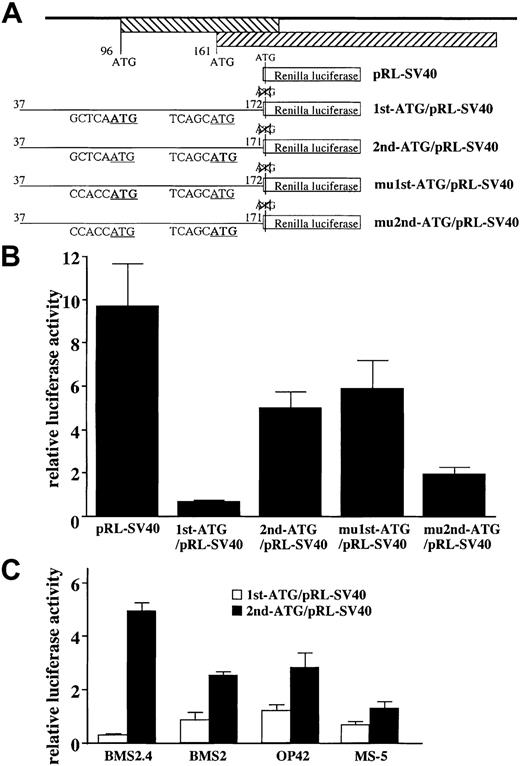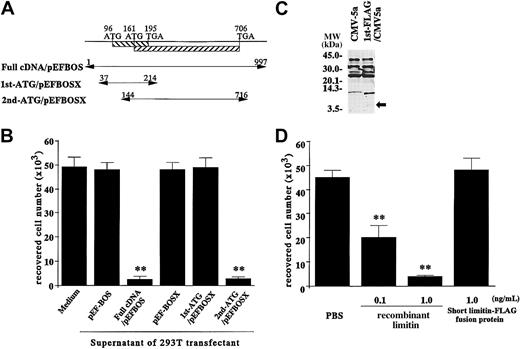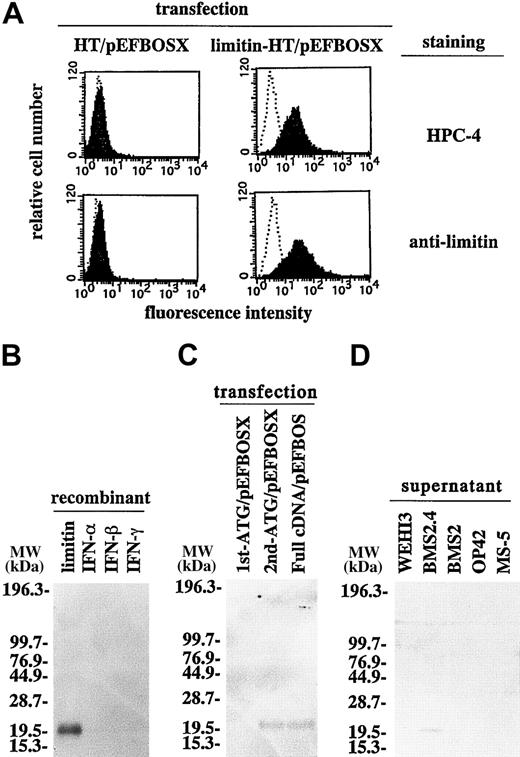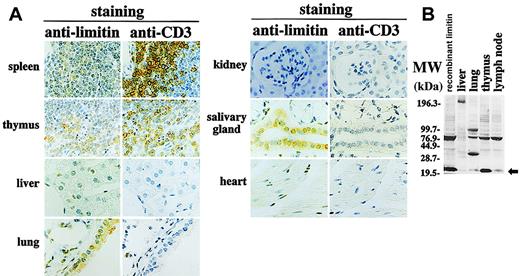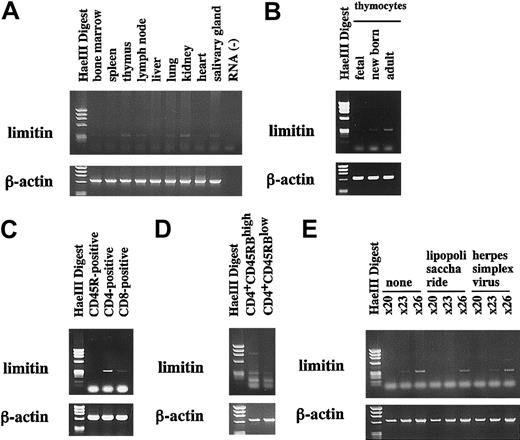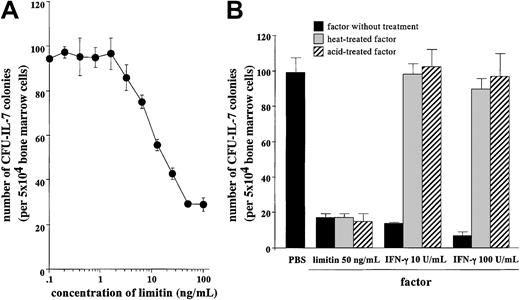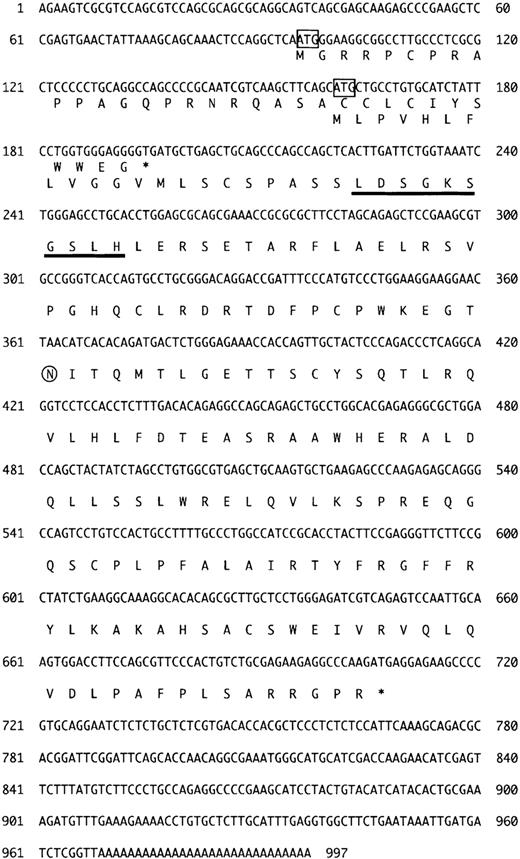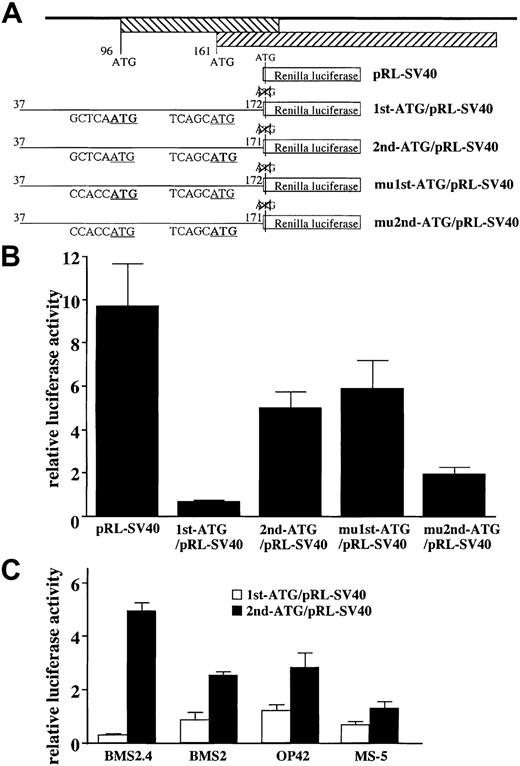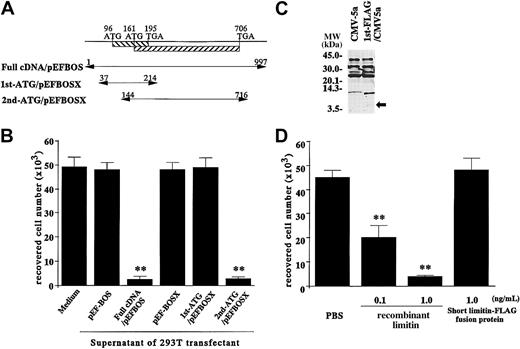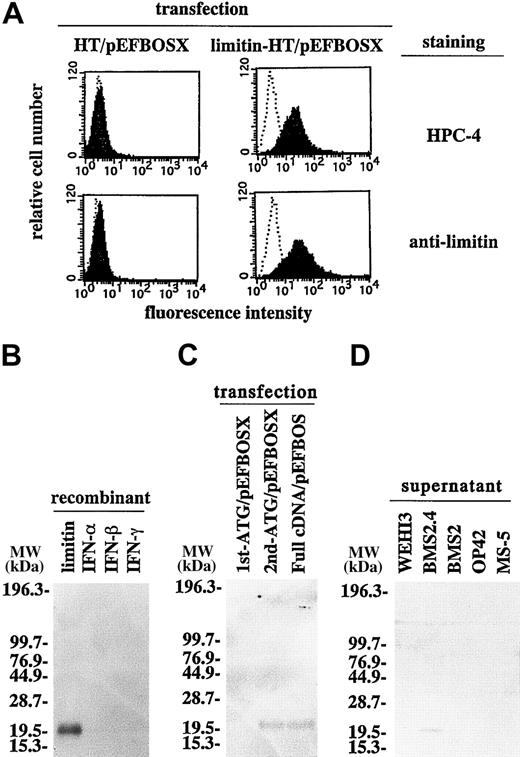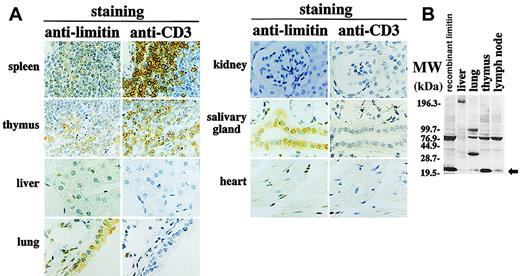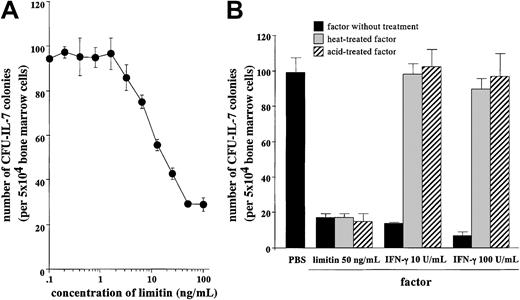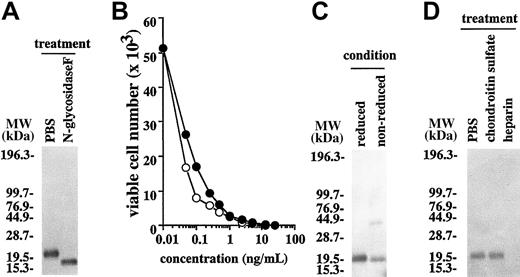Abstract
Several reports have described “multifunctional” eukaryotic mRNAs producing more than one protein through alternative translational initiation at multiple AUG codons. There are 2 such codons in the 5′ region of our recently cloned limitin gene where 2 open reading frames overlap by 34 nucleotides. The deduced protein translated from the first ATG contains 33 amino acids, lacks a signal peptide, and has no obvious effects on the transfected 293T cells. We found that the second ATG is more effective as a translational initiation site than the first ATG and yields a secreted protein of 182 amino acids with the same activity as products made with full-length limitin cDNA. Immunohistochemical and reverse transcription–polymerase chain reaction analysis revealed that the longer limitin protein is produced by mature T lymphocytes in spleen and thymus as well as by bronchial epithelial and salivary duct cells in healthy mice. Properties of recombinant limitin were determined, revealing it to be a serologically distinct, heat- and acid-stable, heparin-binding glycoprotein with the potential for dimerization. Although the longer limitin protein is structurally and characteristically related to type I interferons, its production is uniquely regulated by translation as well as transcription.
Introduction
B-lymphocyte precursors undergo immunoglobulin (Ig) heavy- and light-chain gene rearrangements within bone marrow, and only cells with useful receptors are selected for export to the periphery. The extensive proliferation and differentiation events that accompany this vital process are controlled by signals from the microenvironment.1-6 For example, the orientation and movement of maturing lymphocytes is dependent on transmembrane cell interaction molecules displayed by marrow stromal cells.1,7,8 Culture studies have revealed that stem cell factor, Flt3 ligand, and interleukin 7 (IL-7) are sufficient positive signals for survival and differentiation of murine lymphocyte precursors.9-11 Results of experimental animal studies indicate that steroid hormones are important for limiting the numbers of lymphocytes that are produced under normal and steady-state conditions.12-14 A recently discovered cytokine that we designated limitin is also a potential negative regulator of B lymphopoiesis.15 The deduced limitin sequence has homology with interferon α (IFN-α), IFN-β, and IFN-ω.15Limitin binds to and uses the IFN-α/β receptors on B-lymphocyte precursors.15 As has been reported for type I IFNs, limitin suppressed the proliferation of IL-7–responding pre-B cells and completely blocked the production of B lymphocytes in Whitlock-Witte–type long-term bone marrow cultures.15However, our initial characterization did not reveal influences of limitin on nonlymphoid hematopoietic cells that have been described for IFNs, IL-1, tumor necrosis factor α, and transforming growth factor β.15
It is interesting that the 5′ portion of the limitin cDNA contains 2 ATGs, with 2 corresponding open reading frames that overlap by 34 nucleotides (Figure 1). The first could encode a 33-amino acid peptide that would lack a signal sequence. It could be speculated to have intracellular roles and translation is now demonstrated in this study. Translational initiation at the second of the 2 ATGs would result in a completely different 182-residue secreted protein. Experiments were performed to learn the efficiency of such translation and to authenticate the protein product as biologically active limitin. Although the AUG codon nearest the 5′ end of mRNA is usually a unique site for initiation of translation and most mRNAs in eukaryotes are monocistronic, some mRNAs for proto-oncogenes, transcription factors, and growth factors are regulated at the translational level. Some transcripts can encode 2 or more proteins via alternative translational initiation at different AUG codons.16-23 The functional relevance of such complex arrangements is not well understood, but usually entails some regulation or inhibition. The potent biologic activity of limitin requires that it be produced under rigid and tissue-specific control. We now provide information about the relative translation efficiency from its 2 potential initiation sites. To better understand limitin, we also examined its source in healthy mice and its protein character using newly established polyclonal antibodies specific to the longer limitin protein that is translated from the second ATG.
The genetic organization of the limitin transcript.
cDNA sequence and deduced amino acid sequences of open reading frames translated from the first and second ATGs are shown along with each translational starting codon (boxed). The N-terminal amino acid sequence of the mature protein translated from the second ATG was determined by using amino acid sequencer and shown with a bold underline. The putative N-glycosylation site is circled. The terminal codon is indicated by an asterisk. These sequence data are available from EMBL/GenBank/DDBJ under accession number AB024521.
The genetic organization of the limitin transcript.
cDNA sequence and deduced amino acid sequences of open reading frames translated from the first and second ATGs are shown along with each translational starting codon (boxed). The N-terminal amino acid sequence of the mature protein translated from the second ATG was determined by using amino acid sequencer and shown with a bold underline. The putative N-glycosylation site is circled. The terminal codon is indicated by an asterisk. These sequence data are available from EMBL/GenBank/DDBJ under accession number AB024521.
Materials and methods
Cells and mice
A human transformed embryonal kidney cell line (293T) and mouse stromal cell clones (BMS2.4, BMS2, OP42, and MS-5) were maintained in Dulbecco modified Eagle medium (DMEM; Nakarai Tesque, Kyoto, Japan) supplemented with 10% fetal calf serum (FCS; Gibco, Grand Island, NY). A mouse long-term bone marrow culture–derived pre-B cell clone (BC7.12) was maintained in McCoy 5A medium (Gibco) supplemented with 5% FCS and 5 × 10−5 M 2-mercaptethanol in the presence of 1 ng/mL IL-7 (R & D Systems, Minneapolis, MN).
Balb/c mice were purchased from Nippon SLC (Shizuoka, Japan). All mice were maintained at the Institute for Experimental Animals, Osaka University. To purify CD4+, CD8+, and CD45RA/B220+ cell populations, peritoneal lymph node cells were positive-selected by immunomagnetic beads conjugated with the indicated antibodies (Miltenyi Biotec, Auburn, CA), as previously described.24 In our series, more than 95% of the purified cells always expressed the indicated phenotypes and their viability was higher than 98%.
Plasmid construct
For production of renilla luciferase using the first ATG of the limitin gene, limitin cDNA was amplified by polymerase chain reaction (PCR) with 5′-GGGCTGCAGTCAGCGAGCAAGAGCCCGAAG-3′ and 5′-GGGGCTAGCCACAGGCAGCATGCTGAAGCTTGA-3′. For the construct to produce renilla luciferase using the second ATG of thelimitin gene, limitin cDNA was amplified by PCR with 5′-GGGCTGCAGTCAGCGAGCAAGAGCCCGAAG-3′ and 5′-GGGGCTAGCACAGGCAGCATGCTGAAGCTTGA-3′. The original ATG site for the renilla luciferase protein of the pRL-SV40 plasmid (Promega, Madison, WI) was destroyed by site-directed mutagenesis (null ATG/pRL-SV40). The PCR-amplified fragments were digested withNheI and cloned into the null ATG/pRL-SV40 (1st-ATG/pRL-SV40 and 2nd-ATG/pRL-SV40).
To produce proteins that are translated from the first or the second ATG of the limitin gene, limitin cDNA was amplified by PCR. The oligonucleotide primers used for these reactions were as follows: 5′-GGGCTCGAGTCAGCGAGCAAGGAGCCCGAAG-3′ and 5′-GGGCTCGAGCTGGGCTGCAGCTCAGCA-3′ for the first ATG; 5′-GGGCTCGAGAATCGTCAAGCTTCAGCA-3′ and 5′-GGGCTCGAGCTTCTCCTCATCTTGGGC-3′ for the second ATG. The amplified fragment was digested with XhoI and cloned into the pEFBOSX plasmid that was yielded by site-directed mutagenesis to remove theXhoI site at 3524 of pEFBOS (1st-ATG/pEFBOSX and 2nd-ATG/pEFBOSX).
An Ig/pEFBOSX vector was used to produce Ig fusion proteins composed of CH2 + CH3 cassette of human IgG1.25 The cDNA corresponding to the entire coding region of the limitin protein translated from the second ATG was amplified by PCR with 5′-GGGGCGGCCGCCGCAATCGTCAAGCTTCA-3′ and 5′-GGGCTCGAGCTTGGGCCTCTTCTCGCAGA-3′, and the PCR sample was digested with NotI and XhoI, and ligated into the Ig/pEFBOSX vector (limitin-Ig/pEFBOSX). Limitin-Ig/pEFBOSX produces a fusion protein composed of the protein translated from the second ATG of the limitin gene and human Ig (limitin-Ig).
An HT/pEFBOSX vector was used to produce fusion proteins composed of an HPC4 epitope and a transmembrane domain of tissue factor.25 The cDNA corresponding to the entire coding region of the limitin protein translated from the second ATG was amplified by PCR with 5′ GGGGCGGCCGCCGCAATCGTCAAGCTTCA-3′ and 5′-GGGCTCGAGCTTGGGCCTCTTCTCGCAGA-3′, and the PCR sample was digested with NotI and XhoI, and ligated into the HT/pEFBOSX vector (limitin-HT/pEFBOSX).
Preparation of polyclonal antibody specific to limitin (antilimitin)
The limitin cDNA except for its signal sequence was amplified by PCR with 5′-CGCAATCGTCAAGCTTCAGCATG-3′ and 5′-GAGATTCCTGCACGGGGCTTCTCCTCA-3′. The amplified fragment was digested with NdeI and BamHI and cloned into the pET3a expression vector (limitin/pET3a). Escherichia coli BL21 (DE3) was transformed with the limitin/pET3a plasmid and cultured in the presence of isopropyl thiogalactose (IPTG). The synthesized longer limitin protein was separated by sodium dodecyl sulfate–polyacrylamide gel electrophoresis (SDS-PAGE) of theE coli inclusion body and extracted from the gel. Antilimitin antiserum was raised in rabbits that were immunized repeatedly with the purified longer limitin protein.
Preparation and purification of recombinant limitin protein translated from the second ATG
A pTrace vector (Invitrogen, Groningen, The Netherlands) was used to produce recombinant limitin. The Chinese hamster ovary (CHO) ras no. 1 cells overexpressing recombinant limitin were cultured in DMEM/F-12 medium (Gibco).26 The supernatant was collected after 4 days of culture. The selected recombinant limitin was purified by a combination of immunoaffinity chromatography with antilimitin and ion-exchange chromatography on SP-Sepharose FF (Amersham Pharmacia, Buckinghamshire, England).
Detection of amino acid sequence
293T cells were transfected with limitin-Ig/pEFBOSX. Limitin-Ig was purified from the supernatant of the transfectant with a protein A column. Its N-terminal amino acid sequence was determined using a protein sequencer, model 477A (Applied Biosystems, Foster City, CA).
Luciferase assay
Luciferase assays were performed using the Dual-Luciferase Reporter System (Promega), in which transfection efficiency was monitored by cotransfected pGL-Control vector (Promega), an expression vector of firefly luciferase. The cultured cells were transfected with 10 μg 1st-ATG/pRL-SV40 or 2nd-ATG/pRL-SV40 together with 1 μg pGL-Control vector by lipofectamin transfection method. The transfected cells were lysed in buffer supplied by the manufacturer, followed by measurement of the firefly and renilla luciferase activities on luminometer LB96P (Berthold Japan, Tokyo, Japan). The relative renilla luciferase activities were calculated by normalizing transfection efficiencies according to the firefly luciferase activities.
CFU–IL-7 colony assay
Bone marrow cells were prepared and suspended in 1 mL assay medium as previously described.27 The semisolid agar assay for colony-forming unit (CFU)–IL-7 was done with 1 ng/mL IL-7. Numbers of colonies were counted after 6 days of culture.
Western blot analysis
Supernatants or recombinant limitin were subjected to SDS-PAGE, and the proteins were electrophoretically transferred onto a polyvinylidene difluoride membrane (Immobilion; Millipore, Bedford, MA). After blocking of residual binding sites on the filter, immunoblotting was performed with the antilimitin. Immunoreactive proteins were visualized with the enhanced chemiluminescence detection system (Dupont NEN, Boston, MA).
RT-PCR
Total RNAs (2.5 μg) were reverse transcripted to cDNA at 37°C for 1 hour in total reaction volume of 50 μL comprised of Moloney murine leukemia virus (M-MLV) reverse transcriptase (RT; Gibco), oligo dT (1 μg), 0.1 M dithiothreitol (DTT), 10 μM each dNTP, and 1 × RT buffer. To perform PCR, 10 μL of the above RT mixture was added to PCR buffer containing 1.5 μM MgCl2, 1 U Taq polymerase (Perkin Elmer, Branchburg, NJ), 2 μM each dNTP, and relevant sense and antisense primers. PCR reaction mixtures were amplified under the following conditions: 25 cycles of 94°C for 1 minute, 55°C for 2 minutes, and 72°C for 3 minutes. The oligonucleotide primers used for these reactions were as follows: 5′-TCCAGCGTCCAGCGCAGC 3′ and 5′-CGGAGCTCTGCTAGGAAG-3′ for limitin, and 5′-CCTAAGGCCAACCGTGAAAAG -3′ and 5′-TCTTCATGGTGCTAGGAGCCA -3′ for β-actin.
Immunohistochemical staining
Immunohistochemistry was carried out using paraffin sections of healthy mouse tissues. Deparaffinized sections were incubated in 0.3% hydrogen peroxide in methanol to inactivate endogenous peroxidase. The slides were incubated with antilimitin or anti-CD3 (Dako, Glostrup, Denmark). Binding of the antibody was demonstrated by ENVISION+ system (Dako). As a chromogen, 3, 3′-diaminobenzidine tetrahydrochloride was used.
Results
Preferential translation from the second ATG yields active limitin
The 5′ portion of the originally isolated cDNA clone for limitin consists of a 997–base pair (bp) insert with ATGs at positions 96 and 161, corresponding to 2 distinct open reading frames (Figure 1). This would presumably allow production of 2 completely different proteins containing 33 or 182 amino acids and only the larger has a predicted signal sequence. To analyze which ATG is the major translation initiation site, we constructed 1st-ATG/pRL-SV40 and 2nd-ATG/pRL-SV40 plasmids that produce renilla luciferase under control of the SV40 early enhancer/promoter (Figure 2A). The renilla luciferase protein is translated from the first ATG of thelimitin gene in 1st-ATG/pRL-SV40. Although the 2nd-ATG/pRL-SV40 construct contains both ATGs of the limitin gene, only the second is in-frame for the renilla luciferase protein. The null ATG/pRL-SV40 plasmid whose original ATG for the renilla luciferase protein is destroyed was used for a negative control. As shown in Figure 2B, BMS2.4 cells transfected with 2nd-ATG/pRL-SV40 synthesized renilla luciferase protein more effectively than those transfected with 1st-ATG/pRL-SV40 (> 10-fold). Similar results were observed in all stromal cells examined (BMS2, OP42, and MS-5; data not shown).
The second ATG of the limitin gene is a major transcriptional initiation codon.
(A) Constructs of the pRL-SV40, 1st-ATG/pRL-SV40, 2nd-ATG/pRL-SV40, mu1st-ATG/pRL-SV40, and mu2nd-ATG/pRL-SV40 plasmids. The relative positions of the open reading frames of the limitin proteins with the translational start codons are shown. The open reading frame of renilla luciferase is in frame when the first ATG of thelimitin gene is used as a translational initiation codon (1st-ATG/pRL-SV40 and mu1st-ATG/pRL-SV40). The open reading frame of renilla luciferase is in-frame when the second ATG of thelimitin gene is used as a translational initiation codon (2nd-ATG/pRL-SV40 and mu2nd-ATG/pRL-SV40). (B,C) BMS2.4 stromal cells (B) and the indicated stromas (C) were transfected with the indicated plasmids, together with pGL-Control vector by lipofectamine transfaction. After 2 days of culture, the transfectants were collected and subjected to luciferase assays. The relative renilla luciferase activities were calculated by normalizing transfection efficiency according to the firefly luciferase activities. Results are shown as means ± SDs of triplicate samples. Similar results were obtained in 3 independent experiments.
The second ATG of the limitin gene is a major transcriptional initiation codon.
(A) Constructs of the pRL-SV40, 1st-ATG/pRL-SV40, 2nd-ATG/pRL-SV40, mu1st-ATG/pRL-SV40, and mu2nd-ATG/pRL-SV40 plasmids. The relative positions of the open reading frames of the limitin proteins with the translational start codons are shown. The open reading frame of renilla luciferase is in frame when the first ATG of thelimitin gene is used as a translational initiation codon (1st-ATG/pRL-SV40 and mu1st-ATG/pRL-SV40). The open reading frame of renilla luciferase is in-frame when the second ATG of thelimitin gene is used as a translational initiation codon (2nd-ATG/pRL-SV40 and mu2nd-ATG/pRL-SV40). (B,C) BMS2.4 stromal cells (B) and the indicated stromas (C) were transfected with the indicated plasmids, together with pGL-Control vector by lipofectamine transfaction. After 2 days of culture, the transfectants were collected and subjected to luciferase assays. The relative renilla luciferase activities were calculated by normalizing transfection efficiency according to the firefly luciferase activities. Results are shown as means ± SDs of triplicate samples. Similar results were obtained in 3 independent experiments.
The originally isolated clone, full cDNA/pEFBOS, contained full-length limitin cDNA in the pEFBOS expression vector. We next constructed 1st-ATG/pEFBOSX that produces the shortest limitin gene product and 2nd-ATG/pEFBOSX that produces the larger protein, respectively (Figure3A). Full cDNA/pEFBOS, 1st-ATG/pEFBOSX, or 2nd-ATG/pEFBOSX was transfected to 293T cells, and the supernatants of each transfectant were added to cultures of BC7.12 pre-B cells. As shown in Figure 3, panels B and C, the supernatant of 293T cells transfected with full cDNA/pEFBOS inhibited cell proliferation and induced cell death in BC7.12 cells. Whereas the supernatant of 293T cells transfected with 2nd-ATG/pEFBOSX showed similar growth inhibitory effects on BC7.12 cells, the supernatant of 293T cells transfected with 1st-ATG/pEFBOSX contained no activity. It is noteworthy that no changes in morphology or growth were noticed in 293T cells transfected with any of the constructs. Therefore, no role was apparent for the shortest limitin gene product and previously described activities can be attributed to the longer, secreted protein.
Limitin protein translated from the second ATG but not that from the first ATG has growth-inhibiting properties on BC7.12, a pre-B cell line.
(A) Constructs of the full cDNA/pEFBOS, 1st-ATG/pEFBOS, and 2nd-ATG/pEFBOS plasmids. The relative positions of the open reading frames of the limitin proteins with the translational start and stop codons are shown. The cDNA inserts of each plasmid are indicated by arrows. (B) The full cDNA/pEFBOS, 1st-ATG/pEFBOSX, or 2nd-ATG/pEFBOSX plasmids were transfected into 293T cells with a calcium phosphate precipitation method. The transfectants were cultured for 3 days, and then their supernatants were collected. BC7.12 cells (1 × 104/well) were cultured in the presence of 10% of the indicated supernatants for 2 days. Their viable cell number was evaluated by a hemocytometer. Results are shown as means ± SDs of triplicate samples. Statistically significant differences from control values (P < .01) are indicated by **. Similar results were obtained in 3 independent experiments. (C) Whole cell lysates were prepared from 293T cells transfected with or without 1st-FLAG/CMV-5a, and subjected to Western blot analysis probed with anti-FLAG antibody. The arrow indicates the product from the 1st-FLAG/CMV-5a plasmid. (D) A fusion protein composed of the 33 amino acid short limitin protein and the FLAG tag was purified from cell lysates of 293T cells transfected with 1st-FLAG/CMV-5a by using anti-FLAG affinity chromatography. BC7.12 cells (1 × 104/well) were cultured in the presence of the fusion protein or recombinant limitin for 2 days. Viable cell numbers were then evaluated with a hemocytometer. Results are shown as means ± SDs of triplicate samples. Statistically significant differences from control values (P < .01) are indicated by **.
Limitin protein translated from the second ATG but not that from the first ATG has growth-inhibiting properties on BC7.12, a pre-B cell line.
(A) Constructs of the full cDNA/pEFBOS, 1st-ATG/pEFBOS, and 2nd-ATG/pEFBOS plasmids. The relative positions of the open reading frames of the limitin proteins with the translational start and stop codons are shown. The cDNA inserts of each plasmid are indicated by arrows. (B) The full cDNA/pEFBOS, 1st-ATG/pEFBOSX, or 2nd-ATG/pEFBOSX plasmids were transfected into 293T cells with a calcium phosphate precipitation method. The transfectants were cultured for 3 days, and then their supernatants were collected. BC7.12 cells (1 × 104/well) were cultured in the presence of 10% of the indicated supernatants for 2 days. Their viable cell number was evaluated by a hemocytometer. Results are shown as means ± SDs of triplicate samples. Statistically significant differences from control values (P < .01) are indicated by **. Similar results were obtained in 3 independent experiments. (C) Whole cell lysates were prepared from 293T cells transfected with or without 1st-FLAG/CMV-5a, and subjected to Western blot analysis probed with anti-FLAG antibody. The arrow indicates the product from the 1st-FLAG/CMV-5a plasmid. (D) A fusion protein composed of the 33 amino acid short limitin protein and the FLAG tag was purified from cell lysates of 293T cells transfected with 1st-FLAG/CMV-5a by using anti-FLAG affinity chromatography. BC7.12 cells (1 × 104/well) were cultured in the presence of the fusion protein or recombinant limitin for 2 days. Viable cell numbers were then evaluated with a hemocytometer. Results are shown as means ± SDs of triplicate samples. Statistically significant differences from control values (P < .01) are indicated by **.
Serologic detection and characterization of limitin
A polyclonal antibody was prepared by immunizing rabbits with the full-length recombinant limitin protein translated from the second ATG. It recognized 293T cells expressing a fusion protein composed of the longer limitin protein, an HPC4 epitope, and the transmembrane domain of tissue factor, whereas these did not stain 293T cells transfected with a control plasmid (Figure4A). Western blot analysis with this new reagent revealed that limitin is serologically unique and contains at least one epitope not shared with IFN-α, IFN-β, or IFN-γ (Figure4B). The 293T cells transfected with full cDNA/pEFBOS as well as those transfected with 2nd-ATG/pEFBOSX expressed full-length limitin protein that was recognized by antilimitin (Figure 4C). In contrast, no protein was serologically detected in 293T cells transfected with 1st-ATG/pEFBOSX. Limitin was originally cloned from the BMS2.4 stromal cell subclone, and this was the only one of 5 cell lines that secreted an approximately 20-kDa protein (Figure 4D). Supernates of 3 other stromal cell clones that did not kill pre-B cells and a myelomonocytic leukemia line that did not express limitin transcripts were negative in this Western blot assay. These observations establish the specificity of antilimitin, show that the cytokine is serologically distinct from other IFNs, and confirm that BMS2.4 cells secrete the longer limitin protein translated from the second ATG.
Polyclonal antibody to the longer limitin protein.
(A) 293T cells transfected with the HT/pEFBOSX or Limitin-HT/pEFBOSX plasmids were stained with the indicated antibodies and their immunofluorescent intensities analyzed by flow cytometry. (B) Recombinant limitin, IFN-α, IFN-β, and IFN-γ (50 ng/lane) were subjected to Western blot probed with anti-limitin. (C) 293T cells were transfected with the indicated plasmids. Their supernatants were collected after 3-day cultures and subjected to Western blot probed with antilimitin. (D) The supernatants of the indicated cells were collected after 5 days of culture and subjected to Western blot probed with antilimitin. All panels show 1 of 2 independent experiments.
Polyclonal antibody to the longer limitin protein.
(A) 293T cells transfected with the HT/pEFBOSX or Limitin-HT/pEFBOSX plasmids were stained with the indicated antibodies and their immunofluorescent intensities analyzed by flow cytometry. (B) Recombinant limitin, IFN-α, IFN-β, and IFN-γ (50 ng/lane) were subjected to Western blot probed with anti-limitin. (C) 293T cells were transfected with the indicated plasmids. Their supernatants were collected after 3-day cultures and subjected to Western blot probed with antilimitin. (D) The supernatants of the indicated cells were collected after 5 days of culture and subjected to Western blot probed with antilimitin. All panels show 1 of 2 independent experiments.
Limitin expression in normal murine tissues
Previous PCR analysis suggested that limitin might normally be transcribed in hematopoietic organs, but little information was available about cell types that produce this new cytokine.15 Thus, we used the new limitin-specific antibody for immunohistochemical staining (Figure5). Limitin-containing cells were detected in sections of spleen, thymus, lung, and salivary gland. The T cell–rich zone of the spleen known as the periaortic lymphoid sheath included limitin-positive cells. Furthermore, the antibody recognized cells in the thymic medulla where mature CD3+ cells reside. In addition to T lymphocytes, bronchial epithelial cells and salivary duct cells were strongly positive. No limitin protein was detectable in liver, kidney, or heart. With one exception, these results are compatible with PCR analyses made with whole tissue extracts (Figures 5and 6). Transcripts were detectable in spleen, thymus, lymph node, lung, kidney, and salivary gland, but not in liver or heart (Figure 6A). Note that although limitin mRNA was present in the kidney, no staining was observed by immunohistochemical staining.
Localization of the longer limitin protein in tissues of healthy mice.
(A) Sections of the indicated murine tissues were stained with anti-limitin or anti-CD3 and photographed; original magnification, × 400. (B) Whole cell lysates were isolated from the indicated tissues and subjected to Western blot analysis probed with antilimitin. The arrow indicates the limitin protein. Each photomicrograph and blot shows 1 of 3 independent experiments that gave similar results.
Localization of the longer limitin protein in tissues of healthy mice.
(A) Sections of the indicated murine tissues were stained with anti-limitin or anti-CD3 and photographed; original magnification, × 400. (B) Whole cell lysates were isolated from the indicated tissues and subjected to Western blot analysis probed with antilimitin. The arrow indicates the limitin protein. Each photomicrograph and blot shows 1 of 3 independent experiments that gave similar results.
Limitin mRNA distribution in mice.
(A-C) Total RNAs (2.5 μg) isolated from the indicated tissues (A), the thymocytes of the indicated ages of mice (B), and the subpopulations of lymph node cells purified using immunomagnetic beads conjugated with the indicated antibodies (C) were subjected to RT-PCR. The amplified products were electrophoresed through 1% agarose gels containing ethidium bromide. (D) cDNA from the sorted naive (CD4+CD45RBhigh) and memory (CD4+CD45RBlow) T cells of lymph node cells were obtained using the Cells-to-cDNA kit (Ambion, Austin, TX) and subjected to PCR. (E) Balb/c mice were injected lipopolysaccharide (400 μg/mouse) or herpes simplex virus (5 × 103plaque-forming units per mouse) intraperitoneally. After 24 hours of injection, their lymph node cells were collected and used for RNA preparation, followed by the indicated cycles of PCR. All the panels show 1 of 2 independent experiments that gave similar results.
Limitin mRNA distribution in mice.
(A-C) Total RNAs (2.5 μg) isolated from the indicated tissues (A), the thymocytes of the indicated ages of mice (B), and the subpopulations of lymph node cells purified using immunomagnetic beads conjugated with the indicated antibodies (C) were subjected to RT-PCR. The amplified products were electrophoresed through 1% agarose gels containing ethidium bromide. (D) cDNA from the sorted naive (CD4+CD45RBhigh) and memory (CD4+CD45RBlow) T cells of lymph node cells were obtained using the Cells-to-cDNA kit (Ambion, Austin, TX) and subjected to PCR. (E) Balb/c mice were injected lipopolysaccharide (400 μg/mouse) or herpes simplex virus (5 × 103plaque-forming units per mouse) intraperitoneally. After 24 hours of injection, their lymph node cells were collected and used for RNA preparation, followed by the indicated cycles of PCR. All the panels show 1 of 2 independent experiments that gave similar results.
A more detailed analysis of limitin expression was then performed with enriched populations of lymphocytes from various tissues. As shown in Figure 6B, RT-PCR detected limitin transcripts in CD4+ as well as CD8+ lymph node cells, but not in samples prepared from CD45RA/B220+ cells. Fetal thymocyte suspensions provided an enriched population of immature double-negative cells, whereas mature CD4+ and CD8+ T lymphocytes emerged gradually after birth (data not shown). As shown in Figure 6C, limitin expression was not detectable in fetal thymocytes (gestation day 14), was very faint in newborn thymuses, and increased in intensity with development. These findings suggest that mature T lymphocytes and epithelial cells, but not B lymphocytes, are a natural source of this cytokine in healthy mice.
Structural properties of the secreted limitin protein
The ability to express recombinant limitin will facilitate many types of structure-function analysis. The biologic activity of this material was confirmed using CFU–IL-7 colony assays (Figure7A). Clonal proliferation of B-cell precursors was inhibited in a dose-dependent manner, with maximal activity observed at a concentration of 50 ng/mL. Although IFN-γ lost activity when treated with either acid or heat, recombinant limitin was stable to these treatments (Figure 7B).
Recombinant limitin inhibits IL-7–dependent colony formation and is stable to both acid and heat treatment.
(A) The indicated concentrations of recombinant limitin were added to CFU–IL-7 cultures. The results are shown as means ± SDs of triplicate cultures. (B) Recombinant limitin or IFN-γ was treated with acid (pH 2) or heat (56°C) for 30 minutes. The indicated concentrations of treated factors were added to CFU–IL-7 colony assays. The results are shown as means ± SDs of triplicate cultures. Similar results were obtained in 2 independent experiments.
Recombinant limitin inhibits IL-7–dependent colony formation and is stable to both acid and heat treatment.
(A) The indicated concentrations of recombinant limitin were added to CFU–IL-7 cultures. The results are shown as means ± SDs of triplicate cultures. (B) Recombinant limitin or IFN-γ was treated with acid (pH 2) or heat (56°C) for 30 minutes. The indicated concentrations of treated factors were added to CFU–IL-7 colony assays. The results are shown as means ± SDs of triplicate cultures. Similar results were obtained in 2 independent experiments.
The cDNA sequence corresponding to the longer limitin protein predicts a highly hydrophobic stretch at the N-terminal end and biologic activity was found in the supernatant of transfected 293T cells. Although these facts are consistent with a functional signal peptide, we performed N-terminal amino acid sequencing to determine the precise structure of the mature protein. This revealed the sequence LDXGKSGSLH where X represents one undetermined amino acid residue. This precisely corresponds to the Leu22-His31 segment predicted from the limitin cDNA sequence (Figure 1). Therefore, a signal peptide with cleavage site between Ser21 and Leu22probably facilitates limitin secretion.
The limitin sequence contains a single potential N-linked glycosylation site NXS/T at amino acid residue 68 (Figure 1). As shown in Figure8A, treatment of recombinant limitin with N-glycosidase F changed its mobility in SDS-PAGE from 20 to 16 kDa. Therefore, the longer limitin protein is glycosylated. The limitin sequence contains 6 cysteine residues, and the mature secreted protein has 5 cysteine residues (Figure 1). Migration was slightly faster in SDS-PAGE when recombinant limitin was electrophoresed under reducing rather than nonreducing conditions (Figure 8B). In addition, an approximately 40-kDa band that was seen under the nonreduced condition disappeared following 2-mercaptethanol treatment. Therefore, mature secreted limitin has intramolecular disulfide bonds and may use one cysteine residue for dimerization.
Characterization of the longer limitin protein.
(A) Recombinant limitin was treated with or without N-glycosidase F overnight. The treated proteins were subjected to Western blot probed with antilimitin under reduced conditions. (B) BC7.12 cells (1 × 104/well) were cultured in the presence of the indicated concentrations of recombinant limitin with (●) or without (○) glycosidase F treatment for 2 days. Viable cell numbers were evaluated with a hemocytometer. Similar results were obtained in 3 independent experiments. (C) Recombinant limitin was subjected to Western blot probed with antilimitin under the indicated conditions. (D) Recombinant limitin was immunoprecipitated with heparin-Sephalose in the presence of excess of chondroitin sulfate or heparin. Each precipitate was subjected to Western blot probed with antilimitin. Similar results were obtained in 3 independent experiments.
Characterization of the longer limitin protein.
(A) Recombinant limitin was treated with or without N-glycosidase F overnight. The treated proteins were subjected to Western blot probed with antilimitin under reduced conditions. (B) BC7.12 cells (1 × 104/well) were cultured in the presence of the indicated concentrations of recombinant limitin with (●) or without (○) glycosidase F treatment for 2 days. Viable cell numbers were evaluated with a hemocytometer. Similar results were obtained in 3 independent experiments. (C) Recombinant limitin was subjected to Western blot probed with antilimitin under the indicated conditions. (D) Recombinant limitin was immunoprecipitated with heparin-Sephalose in the presence of excess of chondroitin sulfate or heparin. Each precipitate was subjected to Western blot probed with antilimitin. Similar results were obtained in 3 independent experiments.
Chemokines and certain other cytokines physically interact with heparan sulfate proteoglycans of the extracellular matrix. We determined that recombinant limitin bound to heparin-Sepharose (Figure 8C). This recognition was completely blocked by an excess of free heparin, but not chondroitin sulfate. Furthermore, native limitin protein produced by BMS2.4 cells was enriched and purified with a heparin-Sepharose column (data not shown). These observations show that fully active limitin can be produced in recombinant form and extend our understanding of the secreted protein.
Discussion
This study extends our understanding of the normal expression and biophysical properties of a recently discovered cytokine. The limitin gene contains 2 open reading frames that potentially encode different proteins. However, translational initiation was found to preferentially use the second ATG that encodes the full-length, biologically active cytokine. The protein is serologically distinct from other IFNs and has other characteristics that may be important for its biologic activities. Finally, we show that this potent inhibitor of B lymphopoiesis is constitutively made in healthy animals.
Database searches with the limitin cDNA sequence yield few homologous matches, but many IFNs are retrieved when the analysis is based on the predicted limitin protein sequence. Structural similarity is also paralleled by binding and apparent use of the IFN-α/β receptors.15 IFN-α and IFN-ω are produced by leukocytes, whereas IFN-β is a fibroblast product.28-30These cytokines are produced in limiting quantities under healthy conditions, but synthesis can be dramatically increased by viral infections or exposure to double-stranded nucleic acids.31It was important to learn if limitin is similar with respect to tissue distribution and investigate mechanisms for regulation of its production.
With the exception of one pseudogene, we are unaware of transcripts for any IFN genes that have 2 ATGs within the 5′ segment, as is the case for limitin (Figure 1). Our experiments demonstrate more than 10-fold preference for translational initiation from the second ATG and this results in the secreted, biologically active protein. Although not common, alternative translation sites are used in other eukaryotic genes such as c-myc, cot, glutathione peroxidase, BAG-1/RAP46, catechol O-methyltransferase, HER-2/neu, Pit-1, and molybdopterin synthase.16-23 Multiple proteins translated by alternative initiation from different AUGs were previously shown to yield molecules with discrete functions.16,17 Depending on the cellular environment, expression of 4 isoforms of human BAG-1/RAP46 proteins occurs by alternative translation from 4 different initiation codons.19 Thus, it is important to analyze whether the short limitin gene product has intrinsic activity or only exists to regulate expression of the longer limitin protein translated from the second ATG. Because no obvious changes in morphology or growth were noticed in 293T cells transfected with 1st-ATG/pEFBOSX, it remains unclear if the shortest limitin gene product has a function.
Regulation of translational initiation on eukaryotic ribosomes is known to be complicated, but there is some basis for speculation about how a particular AUG codon is selected when more than one are present.32-36 The 40S ribosomal subunit binds initially at the 5′ end of mRNA and subsequently migrates to the first AUG codon in a favorable context for initiating translation. The 5′-proximal AUG triplet serves as the initiator codon in approximately 95% of mRNAs. However, initiation at downstream AUG codons occurs in some specific circumstances. When the upstream AUG codon is followed shortly by an in-frame terminator codon, ribosomes can reinitiate translation at the next AUG codon downstream. When there are fewer than 10 nucleotides between the cap and the first AUG codon, ribosomes may initiate at both the first and the second AUG codons. The other mechanism by which ribosomes can reach an internal AUG codon is termed “leaky scanning.” This phenomenon occurs when the 5′-proximal AUG codon lies in an unfavorable context for initiation. Manipulating sequences in the vicinity of the AUG initiator codon and analyzing naturally occurring viral bifunctional mRNAs suggest that the optimal context for initiation is CCACCAUGG or CCGCCAUGG. The purine in position −3 (3 nucleotides upstream from the AUG codon) and the G in position +4 (immediately following the AUG codon) are particularly important. In general, when position −3 is the U or the C or when position −3 is the G and position +4 is not the G, “leaky scanning” enables some ribosomes to initiate the second AUG codon. For example, a type of thalassemia has a change in sequence from CACCAUG to CCCCAUG, along with drastically impaired initiation of translation of α-globin.37 The sequence around the first ATG of thelimitin gene is GCTCAATGG and would be classified as “weak” for translation because position −3 is the T. Therefore, ribosomes may initiate the second ATG whose surrounding sequence of TCAGCATGC represents a more favorable context. Therefore, “leaky scanning” could account for why the second ATG of the limitin gene is preferentially used.
Our immunohistochemical analysis revealed that T lymphocytes in thymus and spleen, as well as bronchial epithelial and salivary duct cells, could be sources of the biologically active, full-length limitin protein. With the exception of the kidney, this tissue distribution closely accords with the results of RT-PCR. The apparent absence of protein in an organ that contains mRNA raises the possibility that in addition to transcriptional regulation, protein synthesis can be controlled at the translation or posttranslational steps. Alternatively, these results might be attributable to differences in sensitivities between assays.
Selective staining of the thymic medulla as well as RT-PCR analysis of enriched cell suspensions suggest that mature T cells in central and peripheral lymphoid tissues constitutively produce limitin under normal, steady-state conditions. This raises provocative questions about the function of this cytokine in healthy animals. Limitin is a potent inhibitor of B lymphopoiesis, capable of arresting the process from a very early stage in bone marrow.11,15 B cells are not normally made from stem cells in other tissues and it is possible that limitin contributes to an unfavorable environment. It has recently been shown that the thymus is capable of supporting B lymphopoiesis but is normally prevented from doing so through signals delivered via the Notch/Notch ligand family of molecules.38-40 An additional contribution of limitin is possible. Additional roles for this cytokine in lymphoid tissues might include the surveillance of B-lineage malignancies. Constitutive limitin expression in bronchial epithelial and salivary duct cells raises the possibility of other specialized functions in those restricted areas.
The 3-dimensional crystal structure of murine IFN-β revealed that it is a globular protein with 5 α helices (A-E) and 4 loops.41 A similar crystal structure for a zinc dimer of human IFN-α2b was also reported.42 As a result of computer analysis, the longer limitin protein structure, like IFN-α and IFN-β, is a globular structure with 5 long α helices and a single short helix in the middle of the loop connecting helices B and C.43 In this model, Cys52 and Cys157 as well as Cys80 and Cys130 position very closely to each other. In addition, limitin has an extra cysteine residue at position 61 that could permit dimerization in some circumstances. Our Western blot analysis supports the possibility that limitin has intramolecular disulfide bonds and that it partially dimerizes via the fifth cysteine residue. Type I IFNs differ with respect to N-glycosylation sites, being present in IFN-β and our new cytokine. IFN-α and IFN-β are 15 to 21 kDa and 22 kDa in size, respectively, and the molecular weight of the longer limitin protein is approximately 20 kDa. Additionally, all type I IFNs are acid stable to pH 2 and heat stable, whereas IFN-γ is sensitive to these treatments.28 We show here that limitin is like type I IFNs in this and other respects.
Heparan-sulfated proteoglycans are major components of extracellular matrix.2 Glycosaminoglycan recognition is a feature of certain cell adhesion molecules such as CD31.44Furthermore, this modification is essential for responsiveness of cells to basic fibroblast growth factor.45 Heparan-sulfated proteins can influence the differentiation of hematopoietic cells,46 in part because of their ability to immobilize cytokines such as granulocyte-macrophage colony-stimulating factor, IL-3, basic fibroblast growth factor, IL-7, and IFN-γ.47-50 We found that the limitin protein was recognized by heparin, indicating that it may be focally concentrated by extracellular matrix surrounding limitin-producing cells. Alternatively, interactions with heparan sulfate proteoglycans may influence its localization in other tissues or the ability of cells to respond to it.
Prepublished online as Blood First Edition Paper, June 28, 2002; DOI 10.1182/blood-2002-01-0045.
Supported in part by grants from the Japan Research Foundation for Clinical Pharmacology, the Foundation for Research on Leukemia, the Ministry of Education, Science and Culture of Japan, and the Japan Society for Promotion of Science as well as by grants AI-33084 and AI-20069 from National Institutes of Health.
The publication costs of this article were defrayed in part by page charge payment. Therefore, and solely to indicate this fact, this article is hereby marked “advertisement” in accordance with 18 U.S.C. section 1734.
References
Author notes
Kenji Oritani, Department of Internal Medicine and Molecular Science, Graduate School of Medicine, Osaka University, 2-2 Yamada-oka, Suita, Osaka 565-0871, Japan; e-mail:oritani@imed2.med.osaka-u.ac.jp.


